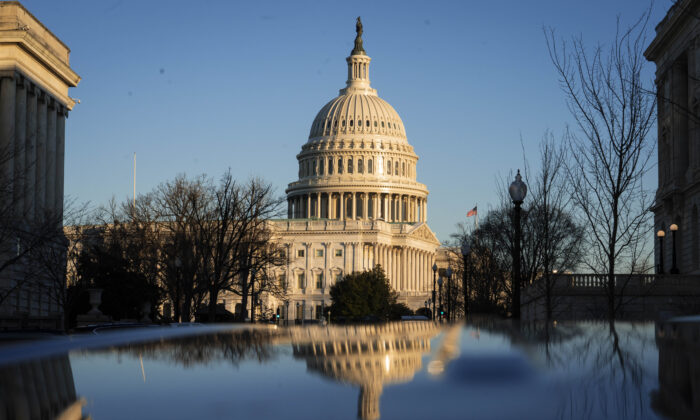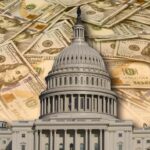By Michael Washburn
News Analysis
As a raft of banks forecast economic pain in 2023, one economic historian warns that the U.S. government’s gargantuan spending programs will push the economy well past its breaking point.
Experts are debating whether the United States is likely to experience a recession. Even the more optimistic forecasts posit that, if a full-blown recession does not occur, a severe downturn will eventuate marked by sluggish growth and higher unemployment.
Morgan Stanley’s 2023 Global Macro Outlook is blunt, predicting that the U.S. economy “will tread water with 0.5% growth.” Moreover, even if inflation eases toward the end of the year, the jobs outlook is dismal, the report suggests.
“Net job gains have slowed markedly over the year and, together with a modest rise in labor force participation, will likely result in a slightly higher (but relatively healthy) unemployment rate of 4.3% in late 2023,” the outlook states.
Top Concern
The negative forecasts come at a juncture when U.S. voters are especially concerned about economic prospects and acutely sensitive to bad news.
Of all the issues of concern to the public in the new year, the state of the economy—as measured by inflation, housing prices, jobs, and other indices—easily outweigh other issues in the minds of voters. According to a poll (pdf) conducted in December by the Associated Press NORC Center for Public Affairs Research, this concern cuts straight across party lines. Democrats and Republicans sharply clash on border security, climate change, and private gun ownership, yet share a broad consensus that the government must get a better handle on the economic issues that define the quality of life for a bulk of the population.
“Among all policy areas, domestic issues continue to be cited most frequently as the public’s most pressing policy concerns … Looking at specific domestic policies, economic issues are the public’s top priority. The biggest concern is the economy in general, with 31% mentioning it as a top priority, slightly more than in June,” the NORC Center’s report states.
Tellingly, the second most-cited concern, in the poll’s findings, namely inflation, is a subsidiary issue of the most-cited, economic concern. A smaller number of respondents, 27 percent, identified immigration as the issue that occupies them the most, while 16 percent cited crime and violence.
The authors of the report summarize their findings bluntly: “Economic issues dominate the public’s agenda for 2023.”
The survey results came as the S&P 500 closed nearly 20 percent lower at the end of 2022 than in the year prior, marking the stock market’s worst overall performance since 2008, and record gas prices caused mass panic.
Meanwhile, the continued slow economic growth, a near anomaly in the broad American historical context, is exacerbated by massive government spending on various policies and programs.
That’s the view of Brian Domitrovic, a professor of economic history at Sam Houston State University in Texas. The period of slow economic growth in which the country now finds itself mired is reminiscent of the 1970s, a decade widely associated with stagnation, Domitrovic believes.
“We had slow growth for a dozen years after 1969, and we also had very short price appreciation in the 1970s, and there was kind of a widespread understanding that nobody had any real solutions that were very good or plausible,” Domitrovic told The Epoch Times.
Power of the Purse
While there are clear parallels, what makes prospects for the coming year even more dismal is the extremely high rate of government spending, he said. Although this is not a new phenomenon, and spending was quite high even under the Republican presidency of George W. Bush back in 2001, the Biden administration’s fiscal profligacy is a game-changer and is not offset by the economic growth that acted as a partial brake on such huge spending in the past, Domitrovic argued.
“When you look at the spending in the 1980s, it went up to 24 percent of GDP from the previous high of 19 percent. That was in the context of racing GDP growth beginning in 1983. We have slow growth now,” he said.
The National Defense Authorization Act (NDAA) allocates $857.9 billion for various departments and programs in fiscal year 2023, including numerous imperatives not strictly related to the defense of America’s borders, such as $800 million for the Ukraine Security Assistance Initiative, $165.3 million for “the continued training and equipping of vetted Syrian groups and individuals,” an independent assessment of the U.S. role in training, advising, and equipping the Somalian military, and the establishment of a “Civilian Protection Center of Excellence” which will serve as “the focal point for matters related to civilian casualties and other forms of civilian harm resulting from military operations involving United States Armed Forces.”
Fuel to the Fire
The massive spending envisioned in the NDAA is among several packages and programs of historical proportions, including notably the Consolidated Appropriations Act 2023 signed by President Joe Biden on Dec. 29, which channels $1.7 trillion in fiscal year 2023 to a host of spending programs.
Another initiative is the Biden administration’s Inflation Reduction Act, which ended up being a slimmed-down version of the president’s $2 trillion Build Back Better Act. It legislation authorized about $433 billion in new spending.
While some features of the economic landscape are familiar from past administrations, the Biden administration is engineering a set of fiscal circumstances virtually without precedent, Domitrovic believes.
“The change is spending. Unprecedented increases in government spending are certainly very recession-oriented. The function of such spending is to cause recessions, since government spending takes up resources that are in the economy,” he said.
Domitrovic sees a further negative factor in the corralling, through government contracts, of citizens who would otherwise be working in the private sector and contributing to GDP growth.
“You make government contracts to take people out and busy them with government work. That’s negative economically, and then you buy their stuff instead of the real market action of the private sector. It’s all dedicated to eliminating resources from the private economy and making those resources inert in real economic transactions. That’s what a recession is,” Domitrovic said.
“Capital interacts with labor to create production. But businesses are becoming more reluctant to commit to capital and labor, and you’re seeing these big layoffs at Amazon. Keep removing resources from the economy, that’s a great way to start a recession,” he added.






